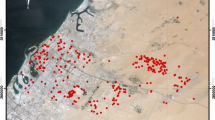Abstract
Prediction of allowable bearing capacity of granular soil requires an intensive field investigation program. This research proposes empirical correlations to predict the allowable bearing capacity and elastic settlement of shallow foundation on granular soils. The current correlation using only standard penetration blow count number and soil unit weight an estimation of the bearing capacity can be attained. Such correlations can be used at the preliminary stage of estimating the allowable bearing capacity and elastic settlement of shallow foundation on granular soils and can help site engineers make immediate decisions in cases of field variations given in soil reports. Moreover, it can be used to create a map for the country in basis of the allowable bearing capacity based on few soil parameters. In this study, database of granular soil properties obtained from 650 boreholes collected from various locations in Sharjah, United Arab Emirates, were used to develop the governing predictive equations. Multiple regression analyses were conducted to develop mathematical models and nomographic solutions to predict the allowable bearing capacity and elastic settlement of shallow foundation. Following development of predictive equations, a set of data collected from 40 boreholes and 20 zone load tests was used to verify validity of the predictive model. The results indicated that the nomographs could effectively predict allowable bearing capacity within ± 15% confidence interval and the elastic settlement within ± 10%.










Similar content being viewed by others
References
Bowles JE (1987) Elastic Foundation Settlements on Sand Deposits. Journal of Geotechnical Engineering, ASCE 113(8):846–860
Burland JB, Burbidge MC (1985) Settlement of foundations on sand and gravel. Proc Inst Civ Eng 78(1):1325–1381
Das BM, Sivakugan N (2007) Settlement of shallow foundations on granular soil—an overview. Int J Geotech Eng 1(1):19–29
De Beer EE (1965) Bearing capacity and settlement of shallow foundations on sand. In: International proc. of the bearing capacity and settlement of foundations symposium. Duke University, Durham, pp 15–34
Erzin Y, Gul TO (2014) The use of neural networks for the prediction of the settlement of one-way footings on cohesionless soils based on standard penetration test. Neural Comput & Applic 24(3–4):891–900
Gupta R, Goyal K, Yadav N (2016) Prediction of safe bearing capacity of noncohesive soil in arid zone using artificial neural networks. Int J Geomech 16(2):04015044. https://doi.org/10.1061/(ASCE)GM.1943-5622.0000514
Hansen JB (1970) Revised and extended formula for bearing capacity. Danish Geotech Inst Copenhagen Bull 28:5–11
Kalinli A, Cemal Acar M, Gunduz Z (2011) New approaches to determine the ultimate bearing capacity of shallow foundations based on artificial neural networks and ant colony optimization. Eng Geol 117:29–38
Marto A, Hajihassani M, Momeni E (2014) Bearing capacity of shallow foundation’s prediction through hybrid artificial neural networks. Appl Mech Mater 567:681–686
Mayne P, Illingworth F (2010) Direct CPT method for footing response in sands using a database approach. The 2nd international symposium on cone penetration testing, Huntington Beach
Meyerhof GG (1956) Penetration tests and bearing capacity of cohesionless soils. Soil Mech Found Div, ASCE 82:1), 1–1),19
Meyerhof GG (1963) Some recent research on the bearing capacity of foundations. Can Geotech J 1:16–26
Nazir R et al (2014) Prediction of spread foundations’ settlement in cohesionless soils using a hybrid particle swarm optimization-based ANN approach. Proc. of the Intl. Conf. On advances in civil, structural and mechanical engineering – CSM 2014, London, pp 20–24
Nazir R et al (2015) An artificial neural network approach for prediction of bearing capacity of spread foundations. Sand Jurnal Teknologi (Sciences & Engineering) 72(3):9–14
Ornek M, Laman M, Demir A, Yildiz A (2012) Prediction of bearing capacity of circular footings on soft clay stabilized with granular soil. Soils Found 52(1):69–80
Padmini D, Ilamparuthi K, Sudheer KP (2008) Ultimate bearing capacity prediction of shallow foundations on cohesionless soils using neurofuzzy models. Comput Geotech 35(1):33–46
Prandtl L (1921) On the penetrating strengths (hardness) of plastic construction materials and the strength of cutting edges. Z Angew Math Mech 1:15–20
Reissner H (1924) Zum Erddruck problem (concerning the earth–pressure problem). In: International proceedings of the first International Congress of Applied Mechanics. Delft, Germany, pp 295–311
Schmertmann JH (1970) Static cone to compute static settlement over sand. J Soil Mech Found Div ASCE 96(3):1011–1043
Schmertmann JH, Hartman JP, Brown PR (1978) Improved strain influence factor diagrams. J Geotech Eng Div ASCE 104(8):1131–1135
Shahin MA, Maier HR, Jaksa MB (2002) Predicting settlement of shallow foundations using neural networks. J Geotech Geoenviron 128(9):785–793
Sivakugan N, Johnson K (2004) Settlement predictions in granular soils: a probabilistic approach. Geotechnique 54(7):499–502
Soleimanbeigi A, Hataf N (2005) Predicting ultimate bearing capacity of shallow foundations on reinforced cohesionless soils using artificial neural networks. Geosynth Int 12(6):321–332
Terzaghi K (1943) Theoretical soil mechanics. John Wiley and Sons, New York
Terzaghi K, Peck RB (1948) Soil mechanics in engineering practice, 1st edn. John Wiley & Sons, New York
Vesic AS (1973) Analysis of ultimate loads of shallow foundations. J Soil Mech Found Div ASCE 99:45–73
Author information
Authors and Affiliations
Corresponding author
Additional information
Editorial handling: David Giles
Rights and permissions
About this article
Cite this article
Omar, M., Shanableh, A., Hamad, K. et al. Nomographs for predicting allowable bearing capacity and elastic settlement of shallow foundation on granular soil. Arab J Geosci 12, 485 (2019). https://doi.org/10.1007/s12517-019-4644-1
Received:
Accepted:
Published:
DOI: https://doi.org/10.1007/s12517-019-4644-1




